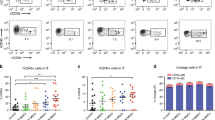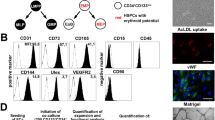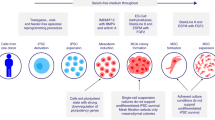Abstract
Summary:
Poor in vivo homing capacity of hematopoietic stem/progenitor cells (HS/PCs) from umbilical cord blood (UCB) can be reversed by short-term ex vivo manipulation with recombinant human stem cell factor (rHuSCF). This study was designed to evaluate the effect of ex vivo manipulation of UCB-derived HS/PCs with rHuSCF on human cell engraftment rates in xenotransplanted NOD/SCID mouse model. The human cell engraftment rates in xenotransplanted primary and secondary NOD/SCID mice were characterized using four-color flow cytometric analysis and progenitor assay. Grafts of rHuSCF-treated UCB CD34+ cells resulted in significantly higher levels of human cell engraftment than that of nontreated ones in both xenotransplanted primary and secondary NOD/SCID recipients. Fresh UCB CD34+ cells did not express either of the matrix metalloproteinase (MMP) family members MMP-2 or MMP-9. rHuSCF-treated UCB CD34+ cells expressed significant levels of MMP-2 and MMP-9. Pretreatment of UCB CD34+ cells with the specific MMP inhibitor completely blocked human cell engraftment in xenotransplanted NOD/SCID recipients. Our results indicate that ex vivo manipulation of human HS/PCs with rHuSCF might provide an optimal approach to develop more effective stem cell-based therapies in situations where engraftment is delayed due to limiting HS/PCs number, for example, UCB transplantation.
This is a preview of subscription content, access via your institution
Access options
Subscribe to this journal
Receive 12 print issues and online access
$259.00 per year
only $21.58 per issue
Buy this article
- Purchase on Springer Link
- Instant access to full article PDF
Prices may be subject to local taxes which are calculated during checkout




Similar content being viewed by others
References
Gluckman E, Rocha V, Boyer-Chammard A et al. Outcome of cord-blood transplantation from related and unrelated donors. N Engl J Med 1997; 337: 373–381.
Rubinstein P, Carrier C, Scaradavou A et al. Outcomes among 562 recipients of placental-blood transplants from unrelated donors. N Engl J Med 1998; 339: 1565–1577.
Gluckman E . Current status of umbilical cord blood hematopoietic stem cell transplantation. Exp Hematol 2000; 28: 1197–1205.
Laughlin MJ . Umbilical cord blood for allogeneic transplantation in children and adults. Bone Marrow Transplant 2001; 27: 1–6.
Gluckman E, Broxmeyer HA, Auerbach AD et al. Hematopoietic reconstitution in a patient with Fanconi's anemia by means of umbilical-cord blood from an HLA-identical sibling. N Engl J Med 1989; 321: 1174–1178.
Wagner JE, Barker JN, DeFor TE et al. Transplantation of unrelated donor umbilical cord blood in 102 patients with malignant and nonmalignant diseases: influence of CD34 cell dose and HLA disparity on treatment-related mortality and survival. Blood 2002; 100: 1611–1618.
Dorrel C, Gan OI, Pereira DS et al. Expansion of human cord blood CD34+CD38− cells in ex vivo culture during retroviral transduction without a corresponding increase in SCID repopulating cell (SRC) frequency: dissociation of SRC phenotype and function. Blood 2000; 95: 102–110.
Xu R, Reems JA . Umbilical cord blood progeny cells that retain a CD34+ phenotype after ex vivo expansion have less engraftment potential than unexpanded CD34+ cells. Transfusion 2001; 41: 213–218.
Bark JN, Weisdorf DJ, DeFor TE et al. Multiple unit unrelated donor umbilical cord blood transplantation in high risk adults with hematologic malignancies: impact on engraftment and chimerism (abstract). Blood 2002; 100 (Suppl 1): 41a.
Vormoor J, Lapidot T, Pflumio F et al. Immature human cord blood progenitors engraft and proliferate to high levels in severe combined immunodeficient mice. Blood 1994; 83: 2489–2497.
Ballen KK, Valinski H, Greiner D et al. Variables to predict engraftment of umbilical cord blood into immunodeficient mice: usefulness of the non-obese diabetic-severe combined immunodeficient assay. Br J Haematol 2001; 114: 211–218.
Hogan CJ, Shpall EJ, McNulty O et al. Engraftment and development of human CD34+-enriched cells from umbilical cord blood in NOD/LtSz-scid/scid mice. Blood 1997; 90: 85–96.
Cashman JD, Lapidot T, Wang JC et al. Kinetic evidence of the regeneration of multilineage hematopoiesis from primitive cells in normal human bone marrow transplanted into immunodeficient mice. Blood 1997; 89: 4307–4316.
Perez LE, Rinder HM, Wang C et al. Xenotransplantation of immunodeficient mice with mobilized human blood CD34+ cells provides an in vivo model for human megakaryocytopoiesis and platelet production. Blood 2001; 97: 1635–1643.
Voermans C, Kooi ML, Rodenhuis S et al. In vitro migratory capacity of CD34+ cells is related to hematopoietic recovery after autologous stem cell transplantation. Blood 2001; 97: 799–804.
van Hennik PB, de Koning AE, Ploemacher RE . Seeding efficiency of primitive human hematopoietic cells in nonobese diabetic/severe combined immune deficiency mice: implications for stem cell frequency assessment. Blood 1999; 94: 3055–3061.
Cashman JD, Eaves CJ . High marrow seeding efficiency of human lymphomyeloid repopulating cells in irradiated NOD/SCID mice. Blood 2000; 96: 3979–3981.
Zheng Y, Watanabe N, Nagamura-Inoue T et al. Ex vivo manipulation of umbilical cord blood-derived hematopoietic stem/progenitor cells with recombinant human stem cell factor can up-regulate levels of homing-essential molecules to increase their transmigratory potential. Exp Hematol 2003; 31: 1237–1246.
Srour EF, Jetmore A, Wolber FW et al. Homing, cell cycle kinetics and fate of transplanted hematopoietic stem cells. Leukemia 2001; 15: 1681–1684.
Jetmore A, Plett PA, Tong X et al. Homing efficiency, cell cycle kinetics, and survival of quiescent and cycling human CD34+ cells transplanted into conditioned NOD/SCID recipients. Blood 2001; 99: 1585–1593.
Peled A, Petit I, Kollet O et al. Dependence of human stem cell engraftment and repopulation of NOD/SCID mice on CXCR4. Science 1999; 283: 845–848.
Kollet O, Spiegel A, Peled A et al. Rapid and efficient homing of human CD34+CD38−/lowCXCR4+ stem and progenitor cells to the bone marrow and spleen of NOD/SCID and NOD/SCID/B2m(null) mice. Blood 2001; 97: 3283–3291.
Hart C, Drewel D, Mueller G et al. Expression and function of homing-essential molecules and enhanced in vivo homing ability of human peripheral blood-derived hematopoietic progenitor cells after stimulation with stem cell factor. Stem Cells 2004; 22: 580–589.
Nagase H, Woessner Jr JF . Matrix metalloproteinases. J Biol Chem 1999; 274: 21491–21494.
Janowska-Wieczorek A, Marquez LA, Nabholtz JM et al. Growth factors and cytokines upregulate gelatinase expression in bone marrow CD34+ cells and their transmigration through reconstituted basement membrane. Blood 1999; 93: 3379–3390.
Lane WJ, Dias S, Hattori K et al. Stromal-derived factor 1-induced megakaryocyte migration and platelet production is dependent on matrix metalloproteinases. Blood 2000; 96: 4152–4159.
Author information
Authors and Affiliations
Corresponding author
Rights and permissions
About this article
Cite this article
Zheng, Y., Sun, A. & Han, Z. Stem cell factor improves SCID-repopulating activity of human umbilical cord blood-derived hematopoietic stem/progenitor cells in xenotransplanted NOD/SCID mouse model. Bone Marrow Transplant 35, 137–142 (2005). https://doi.org/10.1038/sj.bmt.1704751
Received:
Accepted:
Published:
Issue Date:
DOI: https://doi.org/10.1038/sj.bmt.1704751
Keywords
This article is cited by
-
Differentiating neurons derived from human umbilical cord blood stem cells work as a test system for developmental neurotoxicity
Molecular Neurobiology (2015)
-
In-vitro Behavior of Human Umbilical Cord Blood Stem Cells Towards Serum Based Minimal Cytokine Growth Conditions
Indian Journal of Clinical Biochemistry (2014)
-
Ex vivo expansion of umbilical cord blood stem cells for transplantation: growing knowledge from the hematopoietic niche
Bone Marrow Transplantation (2007)



